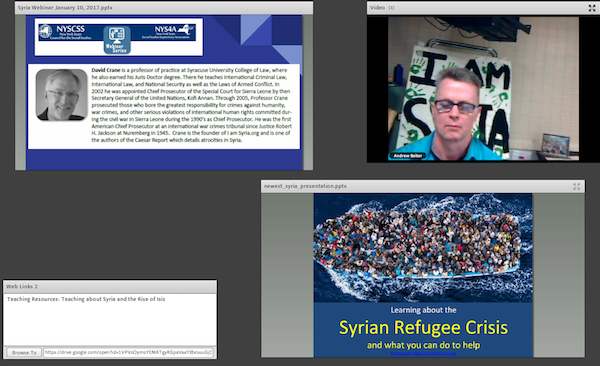Syria Watch
The Day After: Local Truces and Forced Demographic Change in Syria
|
|
|
|
|
|
|
|
|
Syria Deeply: Weekly Update: Renewed Cease-Fire Agreement Amid Rebel Fighting
|
||||||||||||||||||||
|
United Nations News Centre: Syria: UN chief Guterres clarifies tasks of panel laying groundwork for possible war crimes probe
26 January 2017 – Following the approval late last year of an independent panel to assist in the investigation and prosecution of those responsible for war crimes or crimes against humanity in Syria, the United Nations today announced that the mechanism will be headed by a senior judge or prosecutor with extensive criminal investigations and prosecutions experience.
According to a note from a UN spokesperson, the mechanism will be established in phases until it is fully functioning and the Secretary-General will announce the person leading it by the end of February.
The head of the mechanism, which is formally called the ‘International, Impartial and Independent Mechanism to assist in the Investigation and Prosecution of those Responsible for the Most Serious Crimes under International Law committed in the Syrian Arab Republic since March 2011,’ will be assisted by a deputy and a secretariat.
The two primary tasks assigned to the mechanism include:
- Collecting, consolidating, preserving and analyzing evidence of violations of international humanitarian law and human rights violations and abuses; and
- Preparing files in order to facilitate and expedite fair and independent criminal proceedings, in accordance with international law standards, in national, regional or international courts or tribunals that have or may in the future have jurisdiction over these crimes, in accordance with international law.
In discharging its responsibilities, the mechanism will closely cooperate and coordinate with the Independent International Commission of Inquiry on Syria (Syria CoI) and the two panels will be complementary to each other.
“However, there is a clear distinction between the Syria CoI and the mechanism in terms of functions. The Syria CoI focuses on information collection, publicly reporting and making recommendations notably to Member States,” explained the spokesperson.
The mechanism will build on the information collected by others, by collecting, consolidating, preserving and analysing evidence and information. It will also prepare files to assist in the investigation and prosecution of those responsible for the most serious crimes under international law.
The resolution approving the mechanism was adopted by the General Assembly – the universal body comprising all 193 UN Members States – on 21 December by a recorded vote of 105 in favour and 15 against, with 52 abstentions.
See also: Syria: UN approves mechanism to lay groundwork for investigations into possible war crimes
INSCT: Teaching About Syria: David M. Crane Presents to NYSCSS
On Jan. 10, 2017, INSCT Faculty Member David M. Crane joined Andrew Beiter, Education Director, iamsyria.org, at a webinar presented by the New York State Council for the Social Studies (NYSCSS). NYSCSS is a statewide professional organization of school social studies educators.
During the webinar, Crane and Beiter discussed the humanitarian crisis in Syria, the rise of ISIS, and the current situation on the ground, as well as how teachers can approach this topic with students and how students can take action.
Thanks to NYSCSS, this webinar has been released as a video presentation using Adobe Connect. Click here to watch.
Co-founded by Crane, iamsyria.org is a public outreach effort to raise awareness of the humanitarian crisis in Syria, especially aimed at schools. It offers zero-prep, Common Core-friendly lesson plans; educational background articles; ground-truth facts about the civil war; and information on how to take action.









